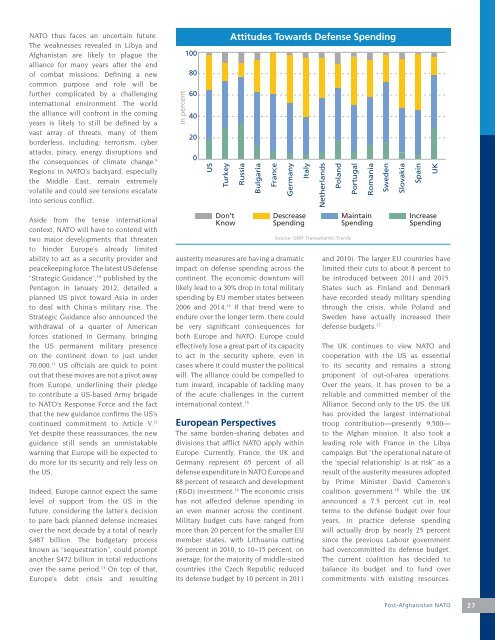BF-FieldManual-FEB13 -3.pdf - Bertelsmann Foundation
BF-FieldManual-FEB13 -3.pdf - Bertelsmann Foundation
BF-FieldManual-FEB13 -3.pdf - Bertelsmann Foundation
- No tags were found...
You also want an ePaper? Increase the reach of your titles
YUMPU automatically turns print PDFs into web optimized ePapers that Google loves.
NATO thus faces an uncertain future.The weaknesses revealed in Libya andAfghanistan are likely to plague thealliance for many years after the endof combat missions. Defining a newcommon purpose and role will befurther complicated by a challenginginternational environment. The worldthe alliance will confront in the comingyears is likely to still be defined by avast array of threats, many of themborderless, including: terrorism, cyberattacks, piracy, energy disruptions andthe consequences of climate change. 9Regions in NATO’s backyard, especiallythe Middle East, remain extremelyvolatile and could see tensions escalateinto serious conflict.Aside from the tense internationalcontext, NATO will have to contend withtwo major developments that threatento hinder Europe’s already limitedability to act as a security provider andpeacekeeping force. The latest US defense“Strategic Guidance”, 10 published by thePentagon in January 2012, detailed aplanned US pivot toward Asia in orderto deal with China’s military rise. TheStrategic Guidance also announced thewithdrawal of a quarter of Americanforces stationed in Germany, bringingthe US permanent military presenceon the continent down to just under70,000. 11 US officials are quick to pointout that these moves are not a pivot awayfrom Europe, underlining their pledgeto contribute a US-based Army brigadeto NATO’s Response Force and the factthat the new guidance confirms the US’scontinued commitment to Article V. 12Yet despite these reassurances, the newguidance still sends an unmistakablewarning that Europe will be expected todo more for its security and rely less onthe US.Indeed, Europe cannot expect the samelevel of support from the US in thefuture, considering the latter’s decisionto pare back planned defense increasesover the next decade by a total of nearly$487 billion. The budgetary processknown as “sequestration”, could promptanother $472 billion in total reductionsover the same period. 13 On top of that,Europe’s debt crisis and resultingin percent100806040200USTurkeyDon’tKnowAttitudes Towards Defense SpendingRussiaBulgariaFranceGermanyausterity measures are having a dramaticimpact on defense spending across thecontinent. The economic downturn willlikely lead to a 30% drop in total militaryspending by EU member states between2006 and 2014. 14 If that trend were toendure over the longer term, there couldbe very significant consequences forboth Europe and NATO: Europe couldeffectively lose a great part of its capacityto act in the security sphere, even incases where it could muster the politicalwill. The alliance could be compelled toturn inward, incapable of tackling manyof the acute challenges in the currentinternational context. 15European PerspectivesThe same burden-sharing debates anddivisions that afflict NATO apply withinEurope. Currently, France, the UK andGermany represent 65 percent of alldefense expenditure in NATO Europe and88 percent of research and development(R&D) investment. 16 The economic crisishas not affected defense spending inan even manner across the continent.Military budget cuts have ranged frommore than 20 percent for the smaller EUmember states, with Lithuania cutting36 percent in 2010, to 10–15 percent, onaverage, for the majority of middle-sizedcountries (the Czech Republic reducedits defense budget by 10 percent in 2011ItalyDescreaseSpendingNetherlandsPolandSource: GMF Transatlantic TrendsPortugalRomaniaMaintainSpendingSwedenSlovakiaSpainUKIncreaseSpendingand 2010). The larger EU countries havelimited their cuts to about 8 percent tobe introduced between 2011 and 2015.States such as Finland and Denmarkhave recorded steady military spendingthrough the crisis, while Poland andSweden have actually increased theirdefense budgets. 17The UK continues to view NATO andcooperation with the US as essentialto its security and remains a strongproponent of out-of-area operations.Over the years, it has proven to be areliable and committed member of theAlliance. Second only to the US, the UKhas provided the largest internationaltroop contribution—presently 9,500—to the Afghan mission. It also took aleading role with France in the Libyacampaign. But “the operational nature ofthe ‘special relationship’ is at risk” as aresult of the austerity measures adoptedby Prime Minister David Cameron’scoalition government. 18 While the UKannounced a 7.5 percent cut in realterms to the defense budget over fouryears, in practice defense spendingwill actually drop by nearly 25 percentsince the previous Labour governmenthad overcommitted its defense budget.The current coalition has decided tobalance its budget and to fund overcommitments with existing resources.Post-Afghanistan NATO2 7






